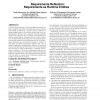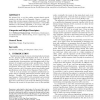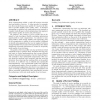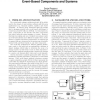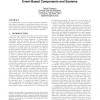ICSE
2010
IEEE-ACM
13 years 10 months ago
2010
IEEE-ACM
Due to the negative impact of code cloning on software maintenance efforts as well as on program correctness [4–6], the duplication of code is generally viewed as problematic. ...
ICSE
2010
IEEE-ACM
13 years 10 months ago
2010
IEEE-ACM
Software clones are identical or similar pieces of code. They are often the result of copy–and–paste activities as ad-hoc code reuse by programmers. Software clones research i...
ICSE
2010
IEEE-ACM
14 years 1 months ago
2010
IEEE-ACM
Computational reflection is a well-established technique that gives a program the ability to dynamically observe and possibly modify its behaviour. To date, however, reflection is...
ICSE
2010
IEEE-ACM
14 years 1 months ago
2010
IEEE-ACM
We present LM, a tool for mining scenario-based specifications in the form of Live Sequence Charts, a visual language that extends sequence diagrams with modalities. LM comes with...
ICSE
2010
IEEE-ACM
14 years 1 months ago
2010
IEEE-ACM
Typestate analysis determines whether a program violates a set of finite-state properties. Because the typestate-analysis problem is statically undecidable, researchers have propo...
ICSE
2010
IEEE-ACM
14 years 1 months ago
2010
IEEE-ACM
The trend towards multicore processors and graphic processing units is increasing the need for software that can take advantage of parallelism. Writing correct parallel programs u...
ICSE
2010
IEEE-ACM
14 years 1 months ago
2010
IEEE-ACM
Many computations exhibit a trade off between execution time and quality of service. A video encoder, for example, can often encode frames more quickly if it is given the freedom ...
ICSE
2010
IEEE-ACM
14 years 1 months ago
2010
IEEE-ACM
ICSE
2010
IEEE-ACM
14 years 1 months ago
2010
IEEE-ACM
Planning iterations in software projects requires considering artifacts from different aspects such as requirements, specifications, tasks or even bug reports. UNICASE is a unifie...
ICSE
2010
IEEE-ACM
14 years 1 months ago
2010
IEEE-ACM
In my dissertation, I aim to develop a dependence-based impact analysis technique for event-based systems and eventbased components that communicate via messages. This paper motiv...

